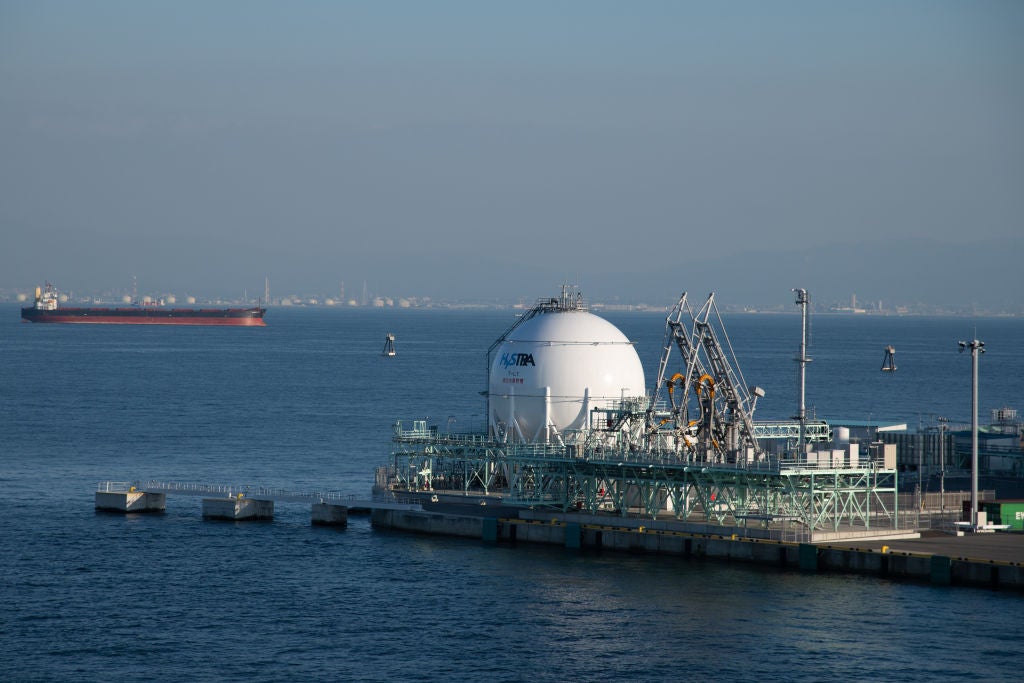
Back in 2017, Japan became the first country in the world to release a national hydrogen strategy. The goal was to take the lead on a low-carbon fuel with high potential, with companies like Toyota pushing hydrogen fuel cell electric vehicles as an effective alternative to battery electric vehicles.
Alongside this came Y40–70bn ($305–534m) per year in government subsidies and support for building out a hydrogen infrastructure. However, today, nearly six years later, Japan has little to show for its initial push. There is no sign that hydrogen can help decarbonise the power and transport sectors as initially envisioned.
“Japan has performed far below its main goal of increasing uptake of fuel cells and fuel cell vehicles, and the hydrogen stations built across the country have seen little use,” noted a report released late last year by the Tokyo-based Renewable Energy Institute (REI), a think tank.
“We are concerned that current government policies will delay the transition to industrial use of [emissions-free] hydrogen, resulting in Japan’s failure to meet its 1.5°C emission reduction target,” says Toshikazu Ishihara, a senior research fellow at the REI and one of the report’s authors. “We are therefore calling for hydrogen not to be used in all processes but more selectively.”
The cost has been high. With the government focused so heavily on hydrogen, Japan neglected other clean energy sectors, lagging its G7 peers in building out domestic wind and solar industries. Japanese companies are also at risk of falling behind on electric vehicles, battery storage and next-generation renewables such as transparent solar panels.
The concern is that the Japanese government, led by the Ministry of Economy, Trade and Industry (METI), has been slow to adapt to global shifts in hydrogen’s perceived best business case. The focus of Japan’s hydrogen strategy, even after updates in 2019 and 2021, remains on passenger transport and power generation. Industry and heavy transport lack clear targets, although these are the priorities for green hydrogen deployment in other parts of the world such as Europe. In fact, several companies including JERA and IHI have launched hydrogen and ammonia power plant co-firing pilots that many experts see as having limited financial or climate benefits.
“One reason for the lack of progress may actually be because Japan is starting with applications where it is not economical to use green or fossil fuel-based hydrogen,” says Seaver Wang of the climate and energy team at the non-profit Breakthrough Institute. “The government is putting big money into pilot projects like hydrogen fuelling stations, vehicle ownership and retrofits to power plants, but there is no broader market uptake.”
Japan: Creating a “hydrogen society”
Japan’s 2017 plan, called the Basic Hydrogen Strategy, set a goal of increasing hydrogen consumption to three million tonnes per year by 2030, and 20 million tonnes per year by 2050, while also driving down the production cost to around one-third of the 2017 level, to Y30 per normal cubic metre. The plan also includes goals for hydrogen fuel cell vehicles and charging stations – 800,000 vehicles and 900 stations by 2030 – and a target of 800,000 tonnes of hydrogen to be used in power generation, accounting for 1% of Japan’s electricity supply. What is notable, says Wang, is what targets are not mentioned – for industry or heavy transport.
“The policy framework in Japan is backwards,” he says, noting that most experts see a primary role for hydrogen in hard-to-abate sectors. “And the policies haven’t changed over time.”
Many connect Japan’s initial hydrogen push to its long-standing role as a major liquefied natural gas (LNG) importer from countries such as Russia, Qatar and Malaysia, often ranking number one in the world. With a vast LNG infrastructure of ports, storage facilities and pipelines, an early argument was that it would be relatively simple to convert this infrastructure to another liquid fuel like hydrogen. That, it turned out, is wrong.
“If you wanted to really make a hydrogen economy, you would need to build it from the ground up,” says Wang. “You can’t use almost any of the existing natural gas infrastructure.”
Japan’s plans focused initially on making use of imported hydrogen and hydrogen-derived ammonia, which is seen as being easier and safer to transport over long distances, with domestic production assumed to take longer to realise. The country is currently importing blue ammonia, made from natural gas with carbon capture and storage (CCS), from the United Arab Emirates. It is also piloting hydrogen shipments: in early 2022, hydrogen produced from Australian coal went via the world’s first hydrogen tanker to the world’s first liquefied hydrogen receiving terminal, which opened in Japan in 2020.
“[Emissions-free] hydrogen is indispensable for Japan to reach its zero-emissions goal,” said Motohiko Nishimura, head of the hydrogen project at Kawasaki Heavy Industries, at a recent conference. “Renewable energy alone isn’t enough to meet the nation’s hefty energy needs.”
For JERA, which is Japan’s largest power generation company, the co-firing of hydrogen and ammonia in its coal-fired power plants is central to its decarbonisation goals. Japan’s first co-firing demonstration project, at Hekinan power station in Aichi, near Nagoya, will utilise a 20% ammonia, 80% coal fuel mix.
“Step by step, we will switch from coal to ammonia,” said Kenji Takahashi, JERA’s general manager for decarbonisation, at the Japan Energy Summit in Tokyo in late February. “By 2040, some of our thermal power plants will use 100% ammonia, and by 2050, by using hydrogen and ammonia, JERA will achieve our goal of net-zero emissions.”
However, Axel Dalman, a researcher with the non-profit Market Forces, suggests this might amount to greenwashing.
“JERA is excited by the idea of being able to use their fossil fuel assets, turn to hydrogen, and at least on paper, reduce their emissions, but on a global scale it doesn’t reduce emissions,” says Dalman. That is because several major Japanese companies, including JERA, Mitsubishi Heavy Industries, Sumitomo Corporation and Mitsui are relying on hydrogen derived from fossil fuels, which Dalman and his colleagues argue could have an adverse climate impact.
“Companies should not rely on fossil hydrogen, it needs to be based on renewable energy, otherwise it is going to increase emissions,” says Dalman.
There are global efforts under way to grow the production of green hydrogen, the term for hydrogen produced with renewable energy. Mitsui and Toyo Engineering are launching a feasibility study to produce green ammonia in Chile, while Japan’s largest electric utility, TEPCO, and the Indonesian national oil and gas company Pertamina are exploring a project that would use geothermal power to produce hydrogen. Meanwhile, JERA just announced, in February, a joint study to produce green hydrogen in the Philippines.
“Certainly switching from blue to green hydrogen would be an improvement,” says Dalman, but he remains cautious, adding that it is unclear if there is enough of a global market for exportable cheap green hydrogen to meet Japan’s needs.
Regional impacts
Climate advocates are concerned that Japan’s push to promote hydrogen and ammonia co-firing in coal plants could have an impact across the entire Asia-Pacific region and particularly in South East Asia due to the large role of Japanese companies there.
Over the past decades, Japan has financed and led the build-out of coal-fired power plants and LNG infrastructure across South East Asia. Japanese companies including JANUS, JAPEX, JGC, JOGMEC, JX Nippon Oil and Gas and Sumitomo are active in the region, including in fossil fuel exploration and development with other national players like Malaysia’s Petronas and Indonesia’s Pertamina.
Japan has promised significant financial support to help decarbonise South East Asia, including $10bn via the METI-led Asia Energy Transition Initiative and $25bn for an Energy Transition Mechanism led by the Asian Development Bank. Japan has also played a leading role in the Indonesia Just Energy Transition Partnership, which promises $20bn to transition that country away from coal.
However, Jacqueline Yujia Tao, South East Asia lead analyst at the non-profit TransitionZero, is concerned that low-carbon investments are not going to renewables like solar, wind or geothermal but to co-firing hydrogen or ammonia in gas/coal plants, or “commercially unproven” technologies such as CCS.
“Japanese energy choices impact the decisions that South East Asian markets make,” said Tao during an online press event in early March 2022. TransitionZero estimates that Japan has invested more than $60bn in planned or under-construction energy projects across the region, mostly in oil, gas and coal.
There is evidence for these investments on the ground. Indonesia’s national electricity company, PLN, is collaborating with Mitsubishi Heavy Industries on a hydrogen and ammonia co-firing feasibility study for three power plants, and has another study ongoing in Thailand. Meanwhile, JERA is collaborating with the Thai Electricity Generating Public Company on a separate coal-ammonia co-firing study. Another Japanese oil and gas company, ENEOS, has announced a “green” hydrogen project with Malaysia’s Petronas.
Han Phoumin from the Economic Research Institute for ASEAN and East Asia (ERIA), a Japanese government supported think tank, argues that without co-firing South East Asia cannot meet its climate goals.
“Coal conversion with hydrogen or ammonia is critical to the energy transition,” said Phoumin at an ERIA event in December 2022. He also believes it is technically and financially feasible. “Some power generation can move forward with 100% hydrogen and ammonia by 2050 or 2060.”
Industrial focus could benefit net-zero goals
For the Breakthrough Institute’s Wang, Japan’s choices are frustrating for many reasons, including that they seem to ignore the potential for hydrogen to play a key role in domestic industrial decarbonisation.
“I would encourage them to target industry first, but it is not being done yet,” he says.
Globally, experts argue that the focus of hydrogen as a clean fuel needs to shift away from vehicles and power generation, to sectors where direct electrification has limited potential, such as heavy industry including decarbonising steel, and heavy-duty transport like trucking, aviation and shipping.
In Japan, this could be especially important as industrial emissions account for around 40% of Japan’s total emissions due to the fact that the country is still a major exporter of steel, automobiles, manufactured goods and high-tech products.
“There are parts of the economy where we need to start looking at unconventional alternatives like hydrogen; for example, in steel,” says Axel Dalman.
While importing green hydrogen could play a role in that, to really scale-up decarbonisation, Japan needs to scale up its production of renewable energy, which can then be used to produce green hydrogen, the researcher suggests.
However, there is a catch. “Domestic green hydrogen is expensive because development of renewable electricity has lagged,” says REI’s Ishihara. “Green hydrogen produced domestically could be competitive with imported hydrogen if the cost of renewable electricity and the cost of electrolysis equipment goes down.”
The Japanese government has taken a step in the right direction, REI notes, with a recent proposition that hydrogen be evaluated based on its greenhouse gas (GHG) emissions intensity in the same way as in the US and EU, although only from 2030.
“The problem is that grey hydrogen, which has high GHG emissions, will be the main source of hydrogen to 2030,” says Ishihara. “The government has projected three million tonnes of hydrogen will be used in 2030, with green or blue hydrogen making up just 14% of that amount, or 0.42 million tonnes.”
Ishihara and Wang hope that Japan will learn from its mistakes and refocus its national hydrogen strategy to be more in line with the global realities of decarbonisation, but also Japan’s own needs to meet its 2050 carbon neutrality goals. “The investment in power generation and transportation are questionable at this point,” says Wang. “It may have been worth it in the 2000s, but now it is throwing good money after bad.”





